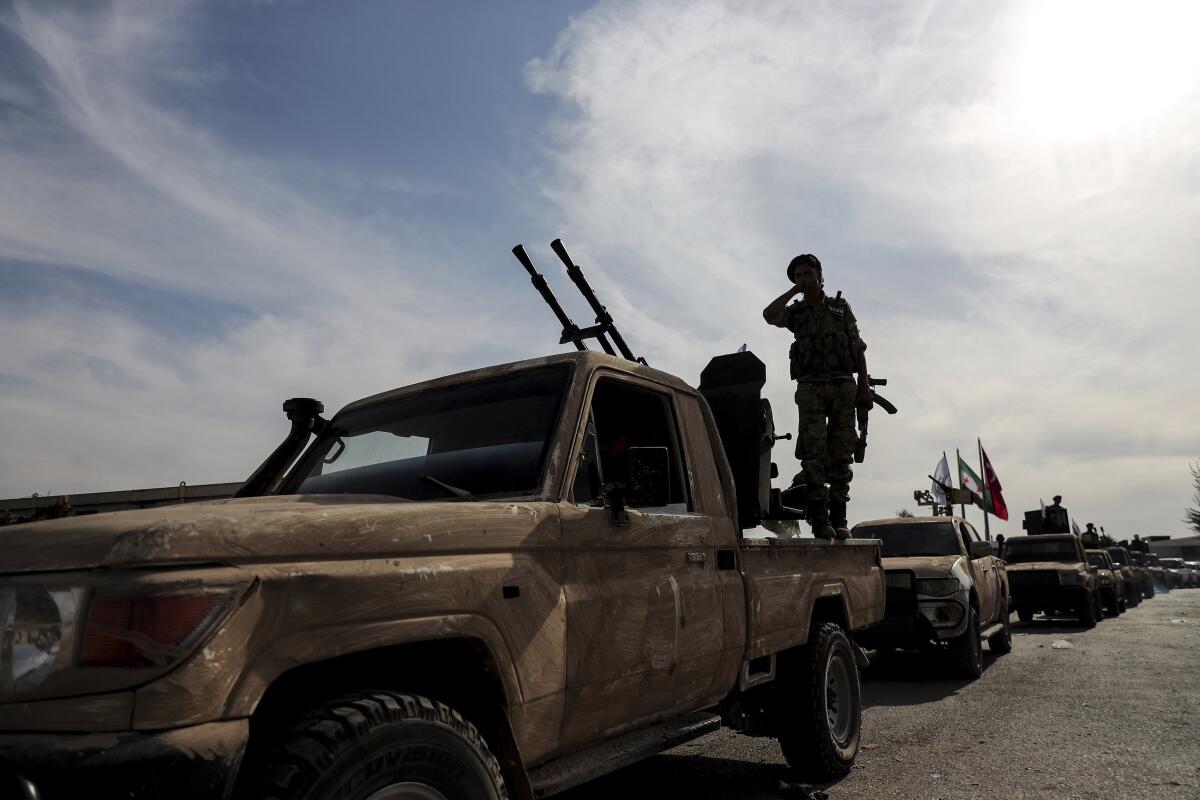Turkey not ‘willing to stop’ incursion into Syria, Pentagon officials say

- Share via
WASHINGTON — Turkey has given no sign it will halt a punishing three-day-old military operation against the Kurds in northern Syria, despite calls by President Trump and European allies for a cease-fire, Pentagon officials said Friday.
Hundreds of Turkish troops and as many as 1,000 Turkish-backed Syrian fighters have crossed into northern Syria along an 80-mile front since Tuesday, supported by airstrikes and artillery fire, the officials said at a news conference Friday.
“I have no indication they are willing to stop,” U.S. Defense Secretary Mark Esper said. “I’m not surprised. … They have been adamant about making this incursion.”
The Turkish advance has thrown northeast Syria into chaos, as Kurdish forces who had been fighting alongside U.S. troops against the militant group Islamic State have moved north to oppose the Turks, while American forces, on the president’s orders, have moved south to stay out of the fighting.
“Naturally there’s a considerable amount of anxiety” among Kurdish fighters, said Gen. Mark Milley, the chairman of the Joint Chiefs of Staff. Kurdish commanders have “given instructions to some of their forces to begin moving north and we’re encouraging them not to overreact.”
Trump has spawned much of the anxiety, starting with an abrupt announcement Sunday that 50 to 100 U.S. special forces along Syria’s border with Turkey were being withdrawn ahead of the Turkish forces. That was followed by a warning to Turkey not to invade, which the government in Ankara has ignored.
On Thursday, Trump ordered U.S. diplomats to seek a cease-fire between Turkey and the Kurds, a goal that both Esper and Milley said appeared unattainable for now.
Turkey’s “incursion on the ground is relatively limited, but the strikes continue,” Milley said.
Adding to the confusion, Trump has claimed in recent days that the U.S. was withdrawing completely from Syria, even though the Pentagon says it is still conducting operations against the remnants of Islamic State and has been given no orders to pull out.
“We are not abandoning our Kurdish partner forces, and U.S. troops remain with them in other parts of Syria,” Esper said.
Amid the conflicting signals, Pentagon officials Wednesday sought to reassure allies in the region that the pullback in Syria did not lessen the U.S. commitment to the wider defense of the region.
Esper announced that the U.S. was sending 3,000 troops to Saudi Arabia, composed of two squadrons of fighter aircraft, three missile defense batteries and other units.
He said the reinforcements are “defensive” and aimed at deterring Iran, which he again accused of being behind an attack on Saudi Arabia’s oil infrastructure last month. Most of the forces were previously announced by the Pentagon in September immediately after that attack.
The U.S. has repeatedly blamed Iran for the attack on the Abqaiq oil processing plant and an oilfield where about 5.7 million barrels are produced each day. But little evidence has been released publicly.
The Pentagon has sent about 14,000 additional troops to the Middle East since March, officials said.
Although Trump is trying to increase pressure on Iran, his measured steps so far reflect a reluctance to use military force and a desire to steer clear of another Middle East conflict.
“The United States does not seek conflict with the Iranian regime, but we will retain a robust military capability in the region that is ready to respond to any crisis and will defend U.S. forces and interests in the region,” Pentagon spokesman Jonathan Hoffman said in a statement.
The more immediate risk is that U.S. forces in Syria will find themselves caught up in the spiraling violence or face a resurgent Islamic State.
Pentagon officials said they have given Turkish counterparts detailed information about the location of U.S. units in northeastern Syria to prevent them from being inadvertently targeted by Turkish forces.
On Friday, a small U.S. military outpost near the Syrian border town of Kobani was hit by Turkish artillery fire, according to a U.S. official. There were no casualties and the attack quickly halted, the official said.
Kobani was the site of fierce battle by Kurdish fighters, who drove Islamic State militants out of the town in 2015 with the help of U.S. airstrikes. It sits outside the border zone where Turkish troops have come across in recent days, causing U.S. commanders to wonder whether the brief attack signaled Turkey was widening its operation.
On Friday, Milley conceded that by drawing Kurdish militias into a fight along the border, “obviously this incursion has had some effect” on U.S. operations against Islamic State.
Kurdish fighters continue to guard detention camps in northern Syria, where as many as 10,000 captured Islamic State members have been held, Milley said. Turkey will have responsibility for guarding detention facilities if their troops take over territory where the facilities are located, he added.
“I have communicated to them multiple times that they are responsible for the security of these ISIS fighters in these prisons,” he added.
But prisoners have already mounted escape attempts, and U.S. officials have not explained how Turkey would take over the facilities without escapes occurring.
More to Read
Get the L.A. Times Politics newsletter
Deeply reported insights into legislation, politics and policy from Sacramento, Washington and beyond. In your inbox twice per week.
You may occasionally receive promotional content from the Los Angeles Times.











